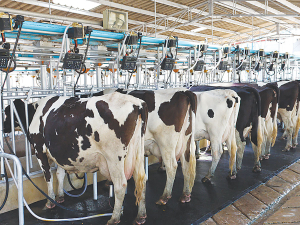Alliance commissions major heat pump system at Mataura, cutting coal use and emissions
Alliance Group has commissioned a new heat pump system at its Mataura processing plant in Southland.
 Most global dairy companies have either set climate targets or made a voluntary commitment to meet targets.
Most global dairy companies have either set climate targets or made a voluntary commitment to meet targets.
OPINION: Reducing greenhouse gas (GHG) emissions – especially scope 3 emissions that occur on the farm – has been on the agenda of leading dairy companies for many years.
Historically, productivity gains have led to more efficient milk production and lower emissions per kilogram of milk, but more comprehensive reduction strategies are needed.
As one can’t reduce what one can’t measure, in 2010 the International Dairy Federation, the Food and Agriculture Organization of the United Nations, and the Sustainable Agriculture Initiative Platform worked together to create a harmonized carbon footprinting methodology for the global dairy sector as a first step in the industry’s emissions reduction pathway.
Most companies in the Global Dairy Top 20 – Rabobank’s annual ranking of the world’s 20 largest dairy companies by turnover – have set climate targets or made a voluntary commitment with the Science Based Targets initiative (SBTi). And more recently, companies – including the majority of the Top 20 – started turning to the SBTi’s Forest, Land and Agriculture (SBTi FLAG) guidance on target setting.
Target levels, timing, and scope can differ among companies depending on their regulatory environment, downstream buyer demands, or public pressure. In this report, we look at the GHG emissions reduction targets of the Top 10 largest dairy companies, plus some of the strategies they are using to achieve these goals.
For scope 3 emissions, several of these companies have committed to a reduction in intensity levels and/or absolute emissions in the range of 30% toward 2030.
The industry has already taken numerous steps to stimulate GHG emissions reduction, such as determining on-farm emissions, creating sustainability programs, and more recently incentivizing farmers through result – and participation-driven premiums (“carrots”).
At the same time, “sticks” will remain part of the equation, with more agriculture and dairy-specific regulation on the way, as well as greater pressure from offtakers to reduce GHG emissions. Not meeting voluntary commitments – like SBTi targets – could have negative consequences for dairy companies going forward, such as reputational damage.
However, to reach 2030 goals and beyond, it is crucial to accelerate the adoption rate of on-farm GHG emissions reduction measures. This is because reductions from productivity and efficiency gains may begin to diminish in developed regions as we move closer to the target date.
After 2030, these targets may only become steeper and, therefore, a wider variety of onfarm mitigation levers are needed. In order to reach the targets set, a well-balanced combination of carrots and sticks is required, as companies are currently unable to reward farmers from downstream market participants’ contributions.
Expanding the financial incentives for farmers will likely require the cooperation and collaboration of participants and stakeholders in the value chain. With such participation, reducing GHG emissions in the dairy value chain in the longterm and accelerating the rate of reduction are believed to be possible.
Why is it important for dairy companies to be proactive?
Dairy companies have been aware of the need to reduce their greenhouse gas (GHG) emissions for many years.
In recent years, companies have faced more pressure from offtakers, end consumers, and other stakeholders – such as NGOs, environmental groups, and even shareholders – to accelerate the reduction of GHG emissions. At the same time, they understand that more regulation is likely and that targets will increase over time.
This has led to more companies proactively making the first moves.
Richard Scheper is RaboResearch’s dairy analyst
According to the latest Federated Farmers banking survey, farmers are more satisfied with their bank and less under pressure, however, the sector is well short of confidence levels seen last decade.
Farmer confidence has taken a slight dip according to the final Rabobank rural confidence survey for the year.
Former Agriculture Minister and Otaki farmer Nathan Guy has been appointed New Zealand’s Special Agricultural Trade Envoy (SATE).
Alliance Group has commissioned a new heat pump system at its Mataura processing plant in Southland.
Fonterra has slashed another 50c off its milk price forecast as global milk flows shows no sign of easing.
Meat processors are hopeful that the additional 15% tariff on lamb exports to the US will also come off.
President Donald Trump’s decision to impose tariffs on imports into the US is doing good things for global trade, according…
Seen a giant cheese roll rolling along Southland’s roads?